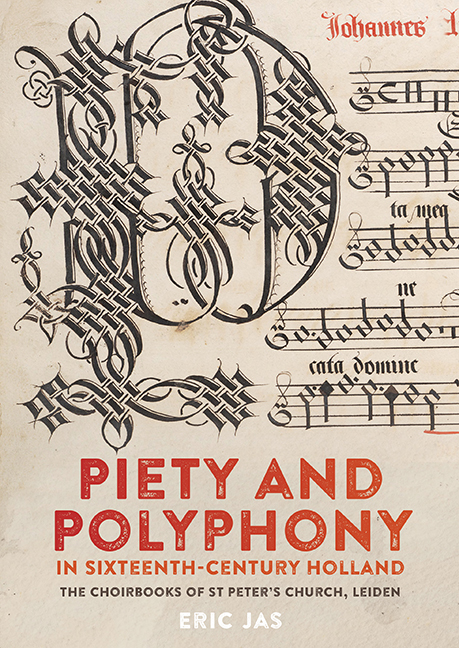Book contents
- Frontmatter
- Contents
- List of Illustrations
- Preface and Acknowledgements
- List of Abbreviations
- Introduction
- 1 The Zeven-Getijdencolleges
- 2 The Seven Hours in St Peter's Church at Leiden
- 3 The Choirbooks of St Peter's Church
- 4 The Repertoire of the Choirbooks
- Epilogue
- Appendix 1 Archival Documents
- Appendix 2 Descriptions and Inventories of the Choirbooks
- Appendix 3 Watermarks
- Alphabetical List of Compositions
- Alphabetical List of Composers
- Concordant Manuscripts and Printed Editions
- Bibliography
- Index
- Studies in Medieval and Renaissance Music
- Frontmatter
- Contents
- List of Illustrations
- Preface and Acknowledgements
- List of Abbreviations
- Introduction
- 1 The Zeven-Getijdencolleges
- 2 The Seven Hours in St Peter's Church at Leiden
- 3 The Choirbooks of St Peter's Church
- 4 The Repertoire of the Choirbooks
- Epilogue
- Appendix 1 Archival Documents
- Appendix 2 Descriptions and Inventories of the Choirbooks
- Appendix 3 Watermarks
- Alphabetical List of Compositions
- Alphabetical List of Composers
- Concordant Manuscripts and Printed Editions
- Bibliography
- Index
- Studies in Medieval and Renaissance Music
Summary
ON Friday 19 January 1526 an incident caused a commotion in the town of Leiden. The sexton of St Peter's had found on the doors of the church and the confessionals four highly injurious notes ridiculing the confession and the all but irreproachable life of members of the clergy. In all probability, these epigrams were no serious cause for concern, as the 1520s had not yet witnessed a strong reformatory movement in Leiden. The notes were, however, recognized as a sign of the growing resistance against prevalent abuses within the Catholic Church. The first powerful expression of this opposition, which would ultimately result in the Reformation, was the iconoclastic fury of 1566. This outbreak raged in Leiden on 25 and 26 August. Alarmed by reports from other towns, the Leiden burgomasters had convened a meeting on Sunday 25 August. The session was interrupted by the sexton of St Peter's, who brought the news that some people wearing red sashes, a symbol of the opponents of Philip II, had entered the church by force and were up to no good. On arriving in St Peter's church the burgomasters and city pensionary found two iconoclasts breaking sculptures. The wrongdoers were pulled out with their combined efforts, and the sextons of the three Leiden churches were ordered to keep the places of worship closed. The Leiden militia was found ready to watch over the churches. In spite of these precautionary measures iconoclasts forced their way into the church of Our Lady in the night of 25 August. During the course of the following day St Peter's church, too, fell victim to the raiding crowd. Altars were desecrated and the statues of the twelve Apostles on the pillars of the choir were destroyed. The iconoclasts were unable to break open the door of the sacristy, however, and next morning the monstrance and other church goods were taken to safety. When the revolt calmed down on 27 August the balance was drawn up. On threat of “corporal punishment or other arbitral correction” citizens were summoned to hand in all goods that had been taken from the churches, convents and other places of worship at the St Jacobsgasthuis (a Leiden hospital built for pilgrims). Furthermore, any violence against clerics or their institutions was forbidden under penalty of hanging.
- Type
- Chapter
- Information
- Piety and Polyphony in Sixteenth-Century HollandThe Choirbooks of St Peter's Church, Leiden, pp. 1 - 3Publisher: Boydell & BrewerPrint publication year: 2018



